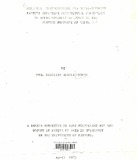| dc.description.abstract | This study is about South Maragoli Location in the Kakamega District of Western Kenya.. The study area
falls within the high potential agricultural lands of Kenya, which are also associated with some of the highest rural population densities in the country. In the case of South Maragoli , the densities vary from 277 to 1064 persons per sq. kilometre. Under such conditions, agricultural production as well as agricultural productivity are faced with serious pressures, because of the declining land availability for individual families who inhabit the
area. The results of these pressures are reflected in the physical deterioration of the land followed by soil erosion as well as by other signs of soil exhaustion the inevitable loss of productivity has created problems of feeding the rural population from the available land. The population pressure has also led to serious land fragmentation as the individual families end our to continue to provide subsistence from the limited land. Shortage of land, as well as landlessness, have therefore become problem to reckoned with. The plight of South Maragoli is comparable to that of many similar densely populated districts in the high potential land areas of Kenya. The study was motivated by the desire to better understand the physical, biological as well as the socio-economic conditions prevailing in such areas, with a view to suggesting solutions on the basis of what could be observed from South Maragoli. The Multiple Linear Regression Technique was used for data collected from the field to study and isolate the main factors influencing agricultural production in the study area. It was established that there are many factors which interact; nevertheless a distinction was made between the physical and biological factors on the one hand,and the socioeconomic factors on the other. Subjecting selected socio-economic factors data to multiple regression analyses revealed that they together explain 67
percent of the observed variation in agricultural production in South Maragoli. Even though it was not possible to test for this statistically, it is assumed that physical and biological factors explain the remaining 33 percent of the observed variation. Among the socio-economic factors studied were the agricultural population, land held by individual household~rs, production methods,and crops used,
the role of agricultural loans and agricultural extension,and the use of co-operatives in the organisation of the marketing of agricultural produce. It was concluded that the average land holding in South Maragoli is too small to provide all the basic necessities required for subsistence, and that the cash crops introduced into the area
like coffee, tea and horticultural crops,could not be relied upon to generate sufficient cash to purchase additional food requirements as well as meet other cash needs of the rural population. To relieve the population pressure there is already a certain amount of out-migration to other districts in western Kenya, but the fundamental problems still remain. It was concluded that the only salvation for rural areas like South Maragoli would be the greater intensification of agriculture to generate more food and cash-from the land to help feed the
existing population. In addition alternative solutions like the settlement of surplus population would have to be resorted to prevent further degeneration or the already overworked agricultural land. Equally important would be intensified soil conservation measures to prevent the deterioration of the land currently in use in the study area.
Finally it is suggested that further research will be required to establish new crops capable of sustaining high rural populations working on small land units operated by small-scale farmers such as
those found in South Maragoli, and to suggest practical and acceptable methods of population
control to prevent a drop in living standards which would be inevitable if nothing is done to check population growth in the location. | en |

